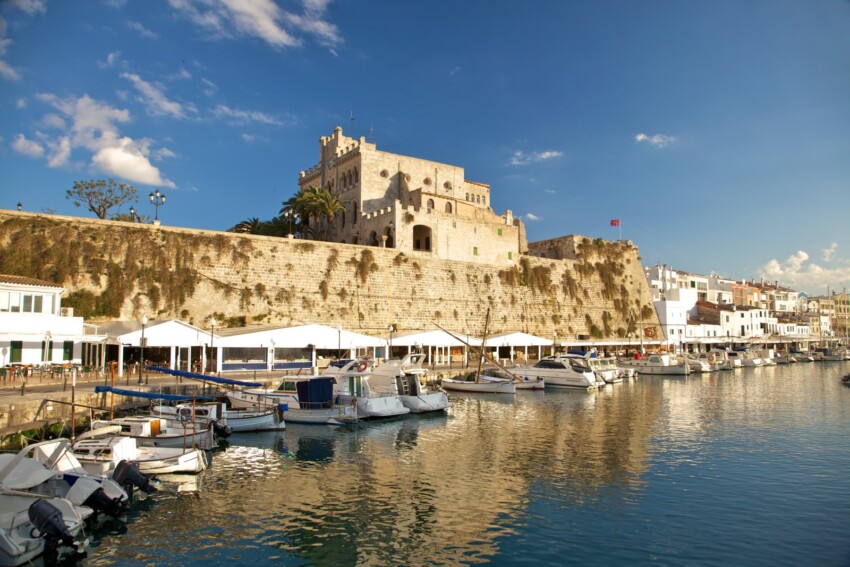

Less crowded and less affected by mass tourism, Menorca is an often underrated destination with a great historical, architectural and natural heritage. Of the Balearic Islands, it is most probably the least famous but Menorca is nevertheless a jewel worth discovering. Everyone who has visited it has fallen in love with it because Menorca is truly a paradise.
It boasts not only beautiful beaches but also numerous natural parks and towns with a long history. Inhabited since the earliest times, Minorca has seen Greeks, Carthaginians, Romans, Arabs, Spaniards, Turks and even the British pass through here. The different dominations that have followed have left important traces of their civilisations.
Its small size makes it perfect as a destination that can be discovered by car in search of the most secluded beach or the most picturesque fishing village, while the high standard of accommodation attracts travellers in search of convenience and comfort. The many opportunities that the island offers make it ideal not only for couples but also for groups of friends looking for fun and relaxation or families discovering new territories.
Here, then, is a mini-guide of the things to see during a stay in Menorca.
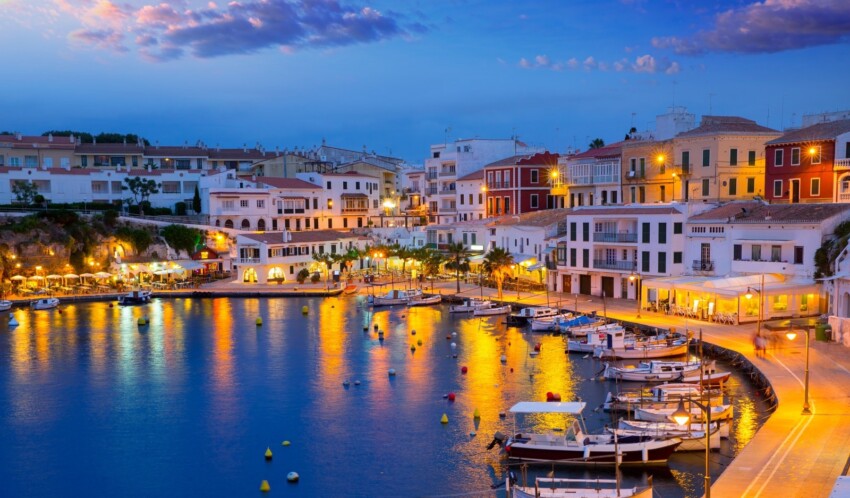
The discovery of Menorca can only start from Mahon, the island’s capital. According to history, the city was founded by the Carthaginian Magon, Hannibal’s brother, and later became one of the most important ports in the Mediterranean. Even today, this port welcomes cruise ships, ferries and tourist boats.
The city is not very big and develops around its characteristic old town and natural harbour, which are connected by a long flight of steps called the Baixamar promenade. To be discovered strictly on foot, Mahón boasts a cosy but rich centre with stately buildings and historic churches such as the Gothic Church of Santa Maria and the Esglèsia de Sant Francesc.
Don’t miss the opportunity to learn more about the island’s history by visiting the Mahón Museum, which allows you to take a real journey through time. After a day exploring the city, you can enjoy a delicious fish dinner at sunset at one of the typical restaurants in the harbour.
Interesting fact: According to several historians and experts, Mahon is the home of mayonnaise, which takes its name from the town.
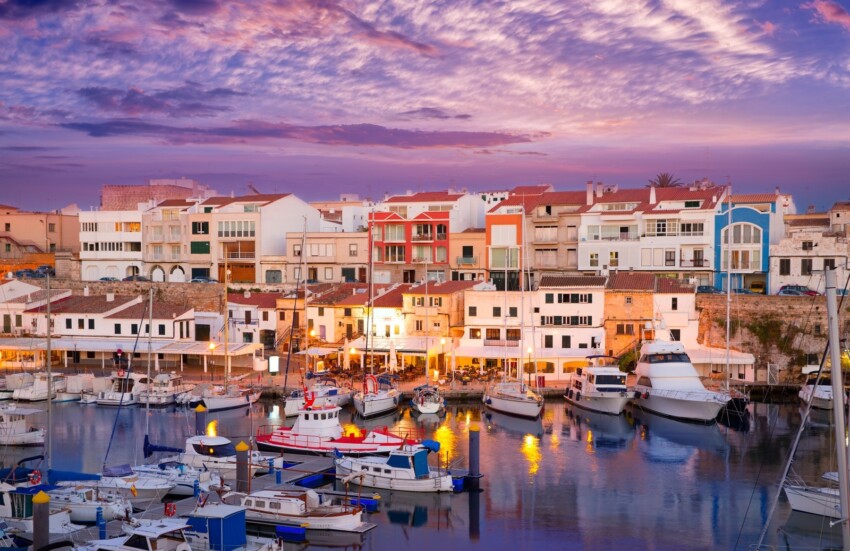
Ciutadella was the capital of the island of Menorca until the 18th century when it was moved to Mahón. The heart of the city is Plaça des Born where you will find the obelisk built to commemorate the citizens who died during the Turkish invasion. Also in the square you can admire the Town Hall, which was erected at the time of Arab rule but was later transformed first into the Royal Palace and later into the Governor’s Palace.
Not to be missed is a visit to the city cathedral, which is in Catalan Gothic style but with a Baroque façade. The church was built in the 15th century on the site of the former central mosque of Medina Minurka so that the minaret of the mosque later became the bell tower. Just outside the city, it is a must to visit the Naveta des Tudons, an archaeological site housing a collective burial site dating back to pre-Talayotic times.
Also worth a visit is the Museo Pintor Torrent, which houses a permanent collection of José Roberto Torrent Prats, one of the most famous local artists.
Ciutadella is also an ideal town for those who like to relax on the beach. In fact, the city lies along the north-western coast of the island, where some of the most beautiful beaches in Menorca can be found. For those who like comfort and services, the best beach is Cala en Bosc, while those looking for wilder shores should head to Son Saura.
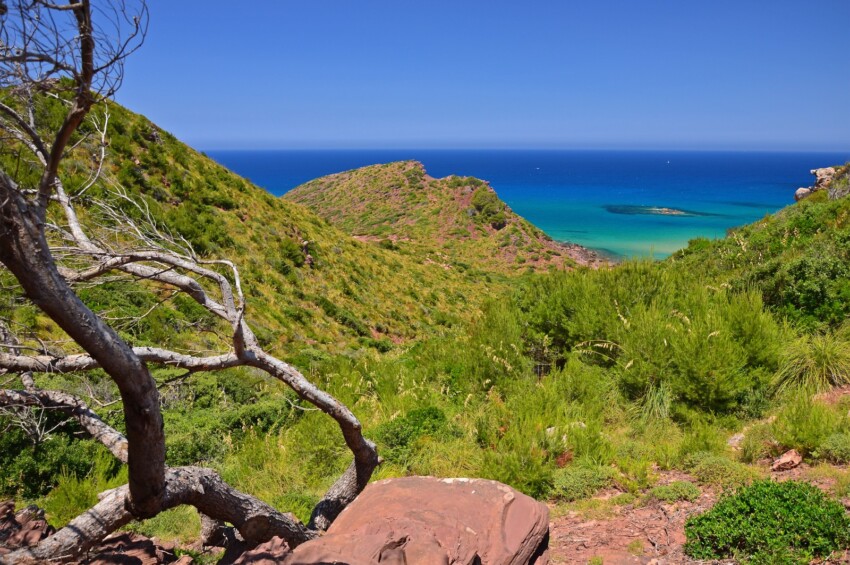
Not everyone knows that Menorca is a World Biosphere Reserve thanks to its rich natural heritage. Among the must-do stops is the s’Albufera des Grau Natural Park, which stretches for about 2 km along the north-eastern part of the island. It is a saltwater lagoon covering an impressive 5100 hectares and is the island’s main wetland. The natural park was established in 1995, and was extended in 2003. Within it are all of Menorca’s main habitats: forests, ponds, dunes, meadows and islets. A large number of animals live undisturbed in it, some of them endemic, including the Balearic lizard.
In addition to a wide variety of flora and fauna, there are also prehistoric remains, uninhabited islets and small lakes. The park boasts three areas: the Island of Colom, the area around the Favaritx lighthouse and the Albufera Lagoon. These three areas present different environments and ecosystems: from wetlands to the countryside, from wooded areas to dunes.
At sunset, you can head to Cap de Favàritx, a promontory with a lighthouse and spectacular views.
The reserve is very wild, but there are three hiking trails that allow you to visit it far and wide, suitable for everyone. Note that there are no facilities to eat or services inside the park, so you need to bring everything you need with you.
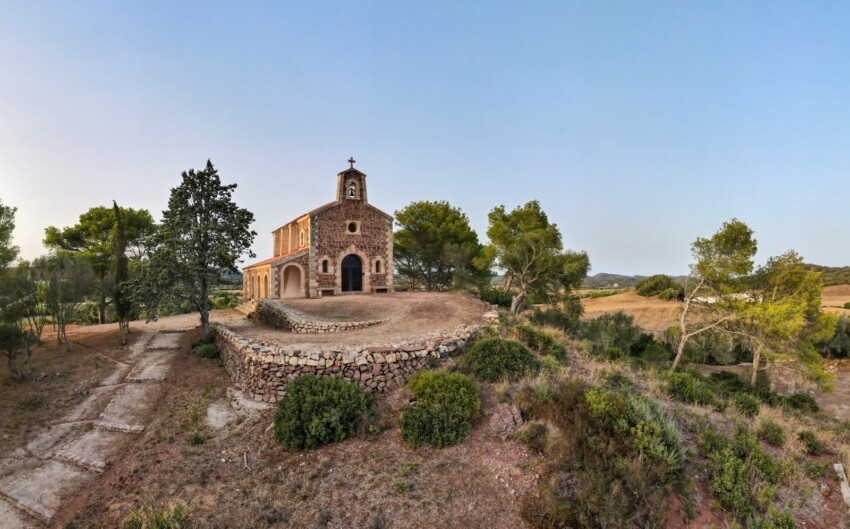
Monte Toro, known locally as El Toro, is not only the most impressive viewpoint on the Balearic island, but also an important spiritual centre. On its summit stands the magnificent Sanctuary of the Madonna of Monte Toro, a place of pilgrimage that dates back to the 13th century and houses the patron saint of Menorca.
The winding road leading to the summit offers breathtaking views across the island, giving visitors panoramas that on clear days extend as far as Mallorca. The religious complex also houses a small but fascinating museum that tells the history of the sanctuary and preserves precious sacred objects.
At sunset, when the sun dips into the Mediterranean, Monte Toro offers an unforgettable natural spectacle, tinging the sky with golden hues that are reflected on the white walls of the sanctuary. The bar-restaurant on the summit allows you to enjoy these magical moments while sampling the local cuisine.
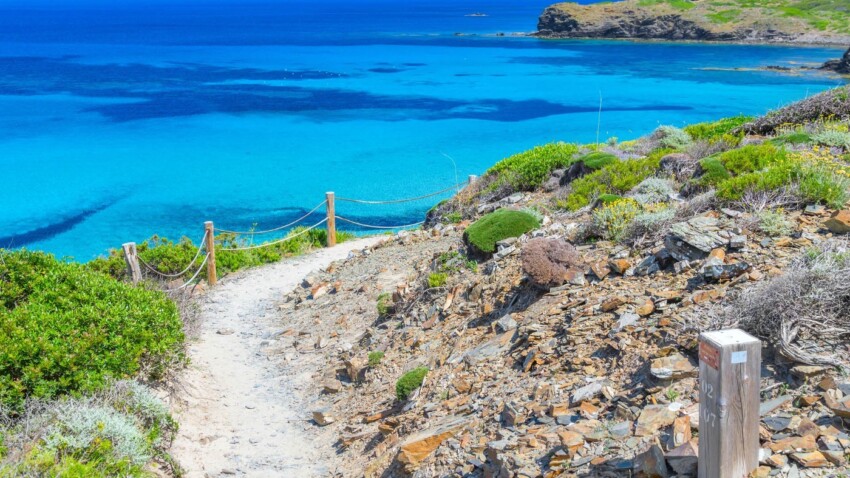
Who said that Menorca is only for beach lovers? The island also welcomes many lovers of open-air activities who can try their hand at different routes here. In particular, the Camí des Cavalls (Trail of the Horses) is an itinerary that can be covered on foot, by bicycle or on horseback.
This path is approximately 185 km long (divided into 20 sections) and runs along the entire coastline of Menorca. Visitors can choose to carve out time to do one or more of the sections of the trail or do the entire route in stages over several days. The route passes through different environments such as forests, fields, olive groves but also paradisiacal bays.
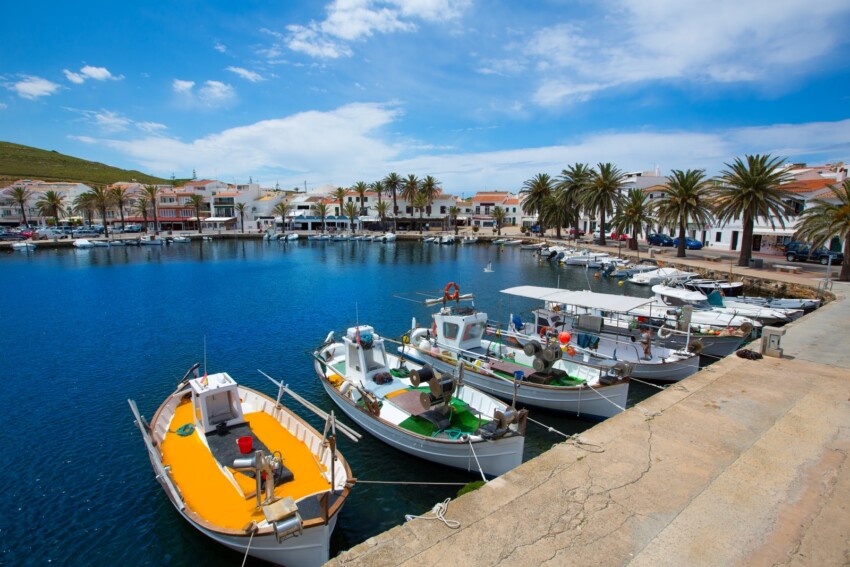
Fornells is a small, quiet fishing village on the north coast of Menorca. Its bay is considered one of the largest natural harbours in the Balearic Islands and around it are several beaches and the island of Sargantanes, which houses a stronghold built during the British rule.
The town is known for being a quiet and peaceful village, the heart of which is the Piazza de la Iglesia. From the square starts Calle Major, the town’s main street with shops, restaurants and boutiques. Fornells’ economy is mainly based on fishing and the town is famous for its lobster fishing, from which the caldereta de langosta, a typical local soup, is prepared.
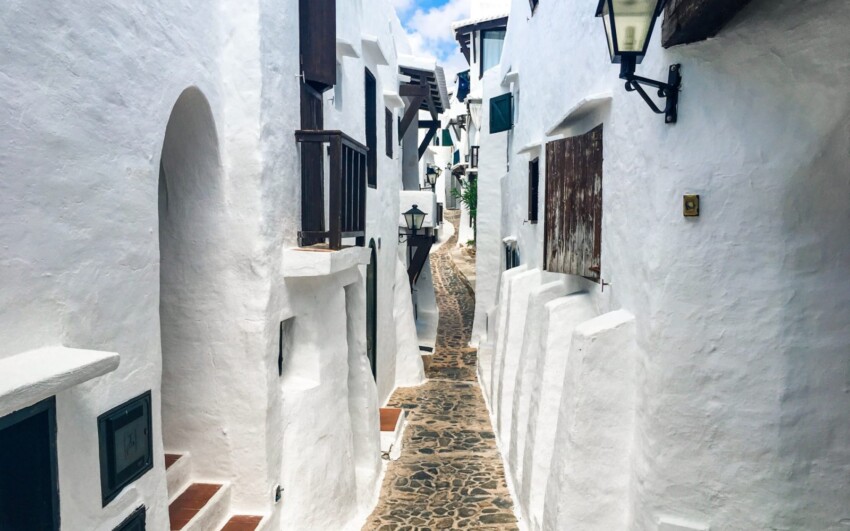
The small village of Binibeca Vell (‘old Binibeca’ translated from Catalan) is located on the south-east coast of Menorca and is part of the municipality of San Luis. It is a small fishing village created in the 1960s by the Ministry of Tourism and designed by architects Antoní Sintes and Javier Barba who wanted to recreate the atmosphere of a quiet Mediterranean coastal village here. Together, the two architects designed and built the village’s 165 houses and its structure.
Over the years, Binibeca has become known as an eco-chic destination on the island with numerous accommodations that have been renovated with the utmost respect for the environment. Strolling through the labyrinthine streets of Binibeca Vell is very pleasant, the houses are all low and white in perfect island style, and here and there you will find shops, bars and restaurants, bustling both day and night. The village is built around a small cove, so the contrast between the white of the houses and the blue of the sea is very striking. It is the ideal location for those who want to spend a holiday in a place with little chaos.
Next to Binibeca Vell is the coastal area of Binibeca, which also includes the beach of the same name, about 200 m long, and the small Cala Torret.
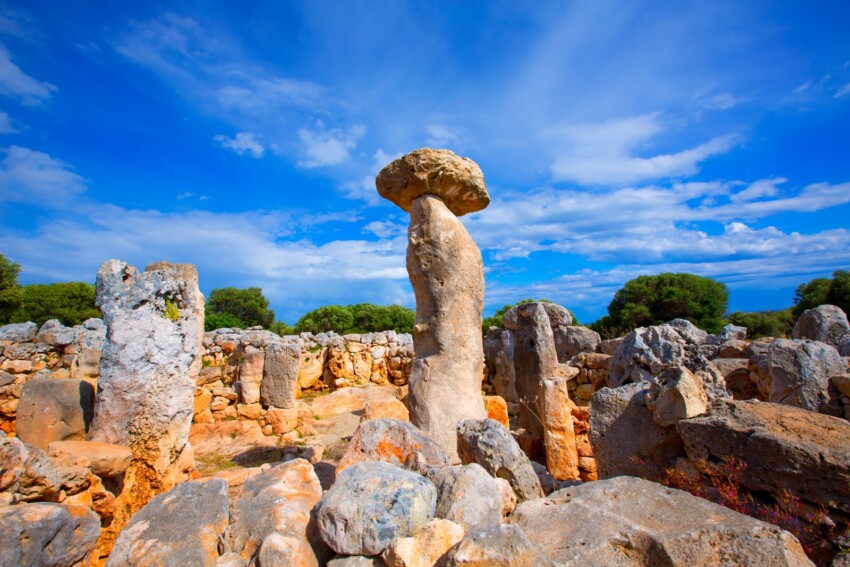
Torre d’en Galmés is a prehistoric village covering approximately 5 hectares and dating back to pre-Palaiotic times. Due to its strategic location, with the centre of the settlement rising on top of a hill, many believe that this town was the most important one on the island.
Inhabited as early as 1300 B.C., this area was also an important centre during Roman times. The talaiot from the word ‘atalaya’ meaning ‘tower’ are typical constructions of the Menorcan landscape. In Torre d’en Galmés, three talaiot can still be found in the highest part of the village around what appears to be a square or ceremonial site.
These constructions are visible from several kilometres away and would have had various functions such as surveillance and control of the territory. In Torre d’en Galmés there is also a taula, a horseshoe-shaped enclosure with a large pillar in the centre, and the hypostyle hall, which was an area used as a warehouse. There are also several ancient houses in the village, although some were altered in Roman times, and a water collection and supply system.
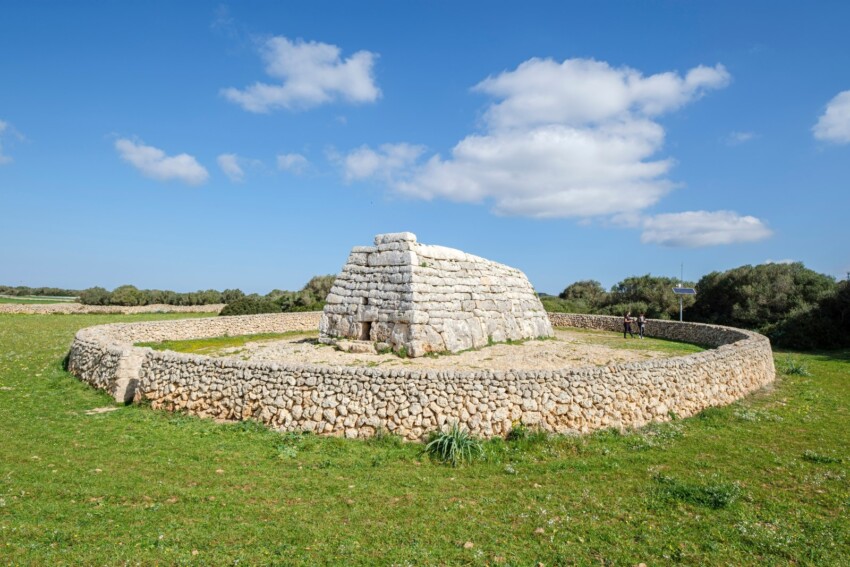
The Naveta d’Es Tudons is said to be the oldest building in all of Europe. Navetas are ancient burial monuments dating back to around 1000 B.C. and were built during the Talayotic period. The name ‘naveta’ derives from the fact that the building externally resembles an inverted ship. The monument has a horseshoe-shaped floor plan and was built with stones without any concrete.
Inside there are two rooms: an ossuary for collective burials and a chamber for grave goods. The Naveta d’Es Tudons was discovered in the 19th century and the remains of bodies and other personal objects of the deceased were also found inside.
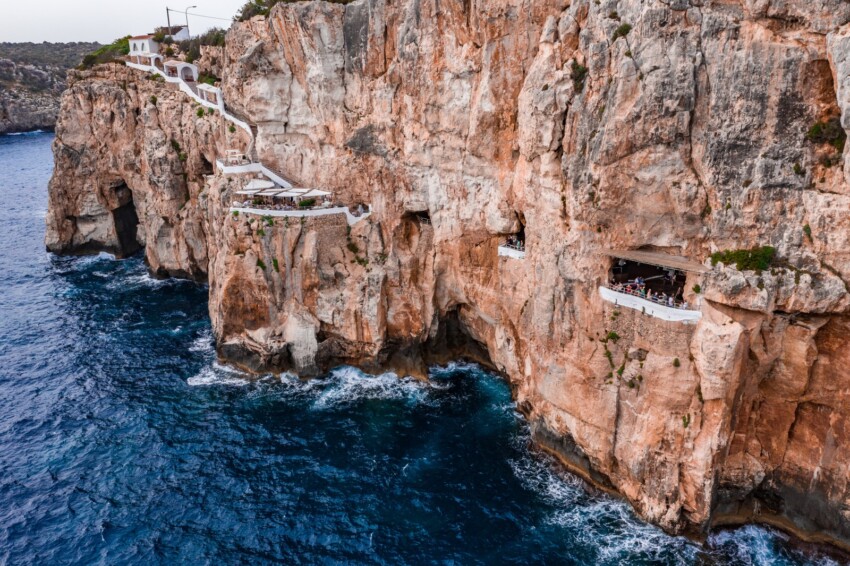
Along the southern coast of the island near the famous resort of Cala en Porter is the ‘Cova d’en Xoroi’, a cave built inside a cliff overlooking the sea. Nowadays, a bar has been opened here that boasts several belvedere terraces and offers its customers beautiful views. The bar is particularly popular at sunset time as the view is truly spectacular, while in the evening it turns into a discotheque that attracts nightlife lovers. One of the highest terraces is reached by climbing a flight of about 90 steps overhanging the sea: the climb requires a bit of effort and courage, but once there, the view is marvellous.
According to a legend, the cave was inhabited for a long time by a young man named Xoroi who had survived a shipwreck and used this cave as a refuge. Xoroi would only come out of the cave to do petty theft in the neighbouring lands and procure food to survive. During one of the outings, however, Xoroi met a beautiful girl who was about to be married, fell in love with her and decided to kidnap her and take her with him to live in the cave. A few years later, while the two were living happily in the cave, an unusual snowfall had fallen on Menorca and some of the inhabitants saw strange footprints leading up to the cave. Following the footprints, they found Xoroi, the woman (whom they thought had disappeared) and her three children. In fear, Xoroi jumped off the cliff followed by his eldest son, while the woman and the other two children were welcomed back to the village.
A few kilometres south of Mahon, beside Cala de Sant Esteve, stands Fort Marlborough, an old fortress built between 1720 and 1726 by the British to protect the town harbour. It takes its name from an English general who lived at the time, Sir John Churchill, Duke of Marlborough.
The fort, which has a heptagonal plan (i.e. with 7 sides), can be visited from the inside; on the upper level of the walls you can enjoy a splendid view of Mahon and its harbour. The visit takes tourists back to the time when the fort was under siege, and depicts the history of Menorca and all of Europe through soldiers in uniform and special effects realised through the use of technology.
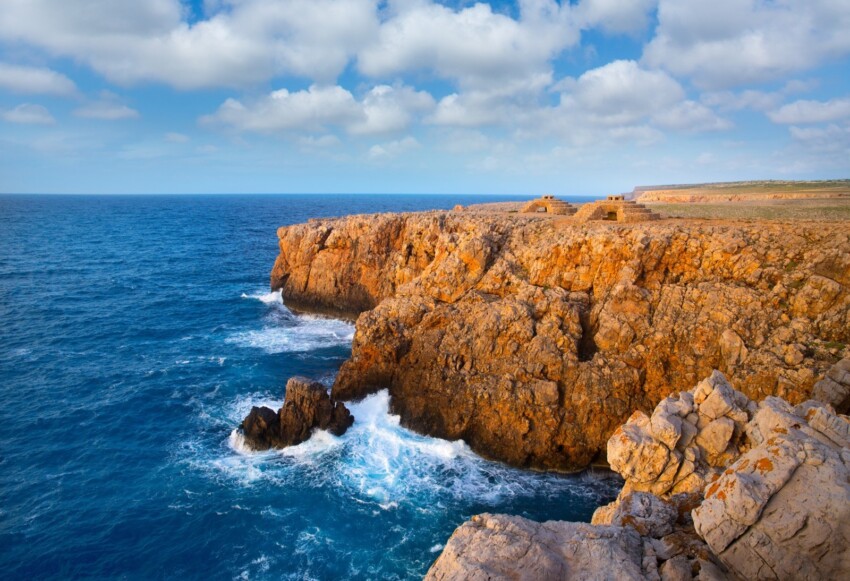
Punta Nati, located in the north-western tip of Menorca, is one of the wildest and most fascinating spots on the island. This rocky, windswept promontory is home to an imposing lighthouse built in 1913, silhouetted majestically against the Mediterranean sky, watching over the turquoise waters crashing against the limestone cliffs.
The lunar landscape of limestone cliffs created by thousands of years of erosion offers a unique setting, where the contrast between the blinding white of the stone and the deep blue of the sea creates an almost surreal atmosphere. The surrounding area, characterised by traditional dry stone walls, tells the story of Menorcan rural architecture.
At sunset, this remote spot becomes the scene of a breathtaking natural spectacle as the sun dips into the horizon, dyeing the lighthouse and cliffs red. Photography enthusiasts will find here a perfect setting to capture the most authentic essence of Menorca, between maritime history and unspoilt natural beauty.
In the following map you can see the location of the main places of interest mentioned in this article.